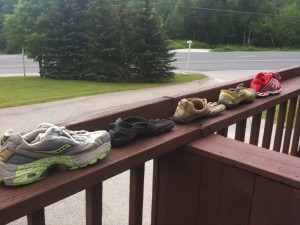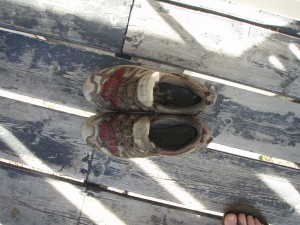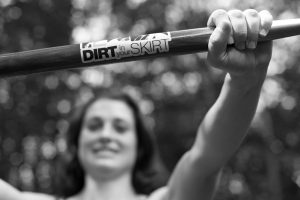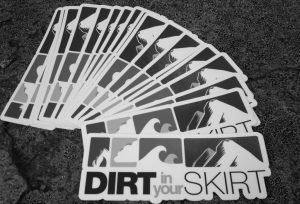A Shoe that Fits
 So, you are new to racing and wondering what the hell do I wear on my feet? If it were a soccer game you wear cleats or skiing simple ski boots, but what about Obstacle Racing? Well, the answer is it depends. I know vague but I will explain. I was posed with the question from a friend what are the best shoes to run a race in. Since I started racing in May 2010, I have worn several types of shoes in competition and each has their advantages. The shoe brands highlighted in this post are purely the ones I have used and continue to use. The best way to describe the pro’s and con’s is through my individual experiences.
So, you are new to racing and wondering what the hell do I wear on my feet? If it were a soccer game you wear cleats or skiing simple ski boots, but what about Obstacle Racing? Well, the answer is it depends. I know vague but I will explain. I was posed with the question from a friend what are the best shoes to run a race in. Since I started racing in May 2010, I have worn several types of shoes in competition and each has their advantages. The shoe brands highlighted in this post are purely the ones I have used and continue to use. The best way to describe the pro’s and con’s is through my individual experiences.
My First Race
 Being that I competed in the first ever Spartan Race in Burlington, Vermont in May 2010, we were all newbs. Obstacle Racing had yet to establish itself and we all were learning as we went. I was a complete newb at running races not only did I wear the wrong clothing as written in “Cotton Stay Away” but also didn’t have a clue as to what to wear on my feet. I pulled out my Salomon Trail Running shoes, which also were Goretex. I loved these shoes to run around and coach the kids in so I figured, sure I will race in these.
Being that I competed in the first ever Spartan Race in Burlington, Vermont in May 2010, we were all newbs. Obstacle Racing had yet to establish itself and we all were learning as we went. I was a complete newb at running races not only did I wear the wrong clothing as written in “Cotton Stay Away” but also didn’t have a clue as to what to wear on my feet. I pulled out my Salomon Trail Running shoes, which also were Goretex. I loved these shoes to run around and coach the kids in so I figured, sure I will race in these.
Lessons Learned
Goretex is good at repelling water but when you have a completely submerged shoe for any period of time it also does a great job of holding water. After the first water section, each shoe weighed about 5lbs. Which comes to the second point, swimming in shoes is HARD, the clunkier the shoe the harder to swim in, fact. However, traditional trail running shoes have one major advantage, they have grip! When running through mud and scaling walls the tread is a welcome helper. So overall, I learned from this race you want tread, but don’t want a Goretex trail shoe as the weight of the shoe does matter when trying to swim.
Second Attempt
 So I read “Born To Run” and like half of the running world that reads that book speed over to the nearest store and bought my first pair of Vibram Five Fingers. I thought they were the answer to the world of running when I got them. But quickly I learned it takes the body a long time to adjust to this style of running.
So I read “Born To Run” and like half of the running world that reads that book speed over to the nearest store and bought my first pair of Vibram Five Fingers. I thought they were the answer to the world of running when I got them. But quickly I learned it takes the body a long time to adjust to this style of running.
My first obstacle race in them, I loved the swimming sections. It felt as if I had nothing on my feet. I loved running in knee-deep mud without the worry of losing a shoe. Unfortunately, they lacked any sort of tread, which made scaling slippery rocks treacherous. Also I learned the hard way how easy it is to break a toe or two trail running in them.
 I upgraded to another pair of VFF’s this pair had some tread on it and was happy for that. However, I found when training for longer races the damage my feet were incurring on longer and longer trail runs wasn’t worth the advantages. I stubbed A LOT of toes in the year plus I ran in them; roots and jagged rocks were like terrorists on a mission to sabotage each run. I also found my second pair of VFF’s pictured to the right wore out really fast. I went through two pairs in a month and a half.
I upgraded to another pair of VFF’s this pair had some tread on it and was happy for that. However, I found when training for longer races the damage my feet were incurring on longer and longer trail runs wasn’t worth the advantages. I stubbed A LOT of toes in the year plus I ran in them; roots and jagged rocks were like terrorists on a mission to sabotage each run. I also found my second pair of VFF’s pictured to the right wore out really fast. I went through two pairs in a month and a half.
Lessons Learned
Overall, I learned from VFF’s that minimalist shoes offer the lightweight alternative I was looking for however they didn’t offer any protection against the unforeseen snares on a trail. They were great in the water, but didn’t offer the grip I was looking for. So I moved on.
Third Attempt
 I wanted to stay on the minimalist movement still compelled by Christopher McDougall. I went searching for a shoe which I wouldn’t constantly be stubbing my toes. I settled on the Merrell Pace Gloves. Yes, I had found the shoe! At least I thought I had. This shoe offered the protection against my ailing toes. It offered the minimalist shoe I craved. I liked not having to wear socks with them. But after extensive testing and racing in them, they still were missing the grip. Also constant movement on the trails with so little padding was no helping my feet and I developed some foot pains.
I wanted to stay on the minimalist movement still compelled by Christopher McDougall. I went searching for a shoe which I wouldn’t constantly be stubbing my toes. I settled on the Merrell Pace Gloves. Yes, I had found the shoe! At least I thought I had. This shoe offered the protection against my ailing toes. It offered the minimalist shoe I craved. I liked not having to wear socks with them. But after extensive testing and racing in them, they still were missing the grip. Also constant movement on the trails with so little padding was no helping my feet and I developed some foot pains.
Lessons Learned
Racing in them they offered the same advantages of the VFF’s in terms of swimming and weight and water drainage but still on the slick mud uphills and slippery walls it was still lacking.
Fourth Times A Charm
 My fourth venture into the world of shoe testing landed me into the world of Inov-8 and more specifically the X-Talon 190. At first, I felt like I was selling out going back into a more traditional shoe. In reality, the shoe doesn’t have much to it but what it has is important. If you want to read all the techie stuff about them check out, “A Girl and Her Shoes” or “Dorothy I’m Keeping These Shoes“.
My fourth venture into the world of shoe testing landed me into the world of Inov-8 and more specifically the X-Talon 190. At first, I felt like I was selling out going back into a more traditional shoe. In reality, the shoe doesn’t have much to it but what it has is important. If you want to read all the techie stuff about them check out, “A Girl and Her Shoes” or “Dorothy I’m Keeping These Shoes“.
For the Cliff’s Notes version, basically this shoe offers the minimalist feel (3mm heel to toe drop). It offers the grip needed for muddy trails and obstacles, it has what can be best described as lugs on the bottom of the shoe, and it’s really lightweight (190 grams per shoe). The weight is important when swimming in them. Finally, and one of the most important is that this shoe doesn’t hold water! I learned this during several races during my 2011 season.
Conclusion
Does this mean that my search for the ultimate Obstacle Running shoe is over? Yes, until tomorrow when a better shoe comes along. I am always on the lookout for the best shoe to optimize my race experience. If I were able to highlight the most important features in a good Obstacle Racing shoe they would be:
- Lightweight
- Good Tread
- Good Drainage
- Protection from Rocks/Roots
Ultimately, the most important thing for race day is to do what you know! Don’t try out new shoes the day of a race. Any shoe you are comfortable in can be the best shoe for that day. If you are comfortable you will be able to run a much better race overall. Just get out an enjoy!









